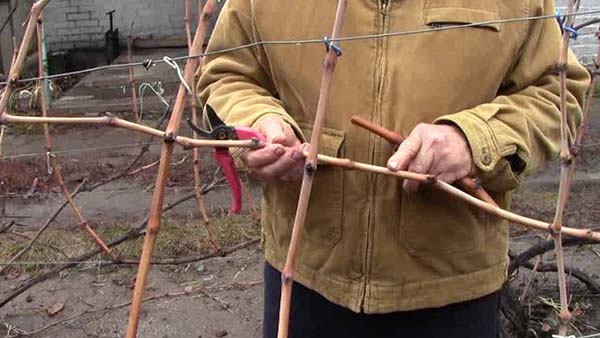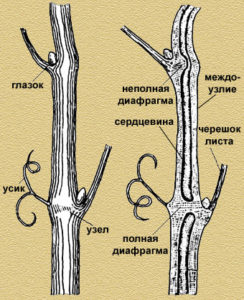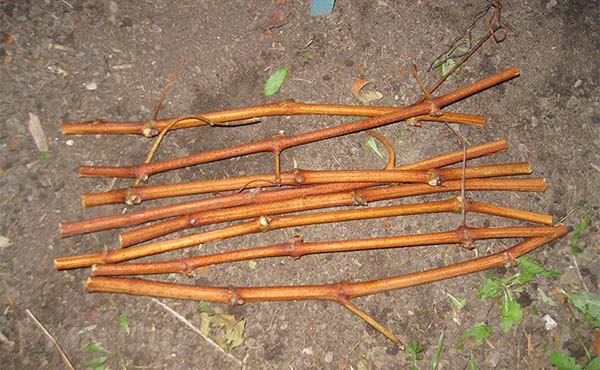Cutting grapes in the fall: rules for harvesting cuttings at home
Since biblical times, interest in grapes, its most diverse types and varieties, has not waned. To get enough of the best varietal planting material, put your hands on the cuttings! This is a very real way to propagate your favorite variety, as well as acquire a completely new high-quality grape seedling.
The advantages of autumn grape cuttings, the timing of harvesting cuttings, the intricacies of correct cuttings will be discussed in our article.

Content
Benefits of propagating grapes by cuttings in the fall
There are several ways to propagate grapes, for example, by layering (digging in shoots) and even planting seeds, but one of the most popular and best is the cultivation from cuttings.
Actually, this is why many experienced gardeners choose grape propagation in autumn as a method of grape propagation:
- After autumn grape pruning you have a lot of good vine left, which will be just excellent material for propagation by cuttings.
Note! Uncovering grape varieties that are pruned in the spring, of course, are cut in the spring.
- It is not known how the vine will survive the frost. Suddenly you got it wrongcover for the winter, and it will partially freeze out.
- Having prepared the shanks in the fall, you can put them on germination in early spring or even at the end of winter (in February-March).
Interesting! It is more correct to call the cuttings of grapes "shanks".
When to carry out autumn grape cuttings
The harvesting of grape cuttings is carried out during autumn pruning vines, which means that your reference point will be the moment when the first frosts will pass, the earth will stick a little, and the yellowed leaves will completely fall off the bush.

Thus, the approximate timing of grape cuttings in autumn in the middle lane (Moscow region) is the second half of October-early November.
How to harvest grape cuttings in autumn: basic rules for grape cutting
When grapes are cut in autumn, the following recommendations should be followed:
- Only cuttings should be selectedwell-ripened annual shoots with a diameter of 0.5-1 cm... That is, their thickness should be approximately equal the thickness of a pencil or pen.

Advice! Too thick (more than 1 cm) will not work, because these are fattening shoots, and they will hardly be able to root normally.
The same applies to shanks that are too thin - they will take too long to take root.
- In this case, the vine should be enough firm, and if you bend it a little, it will crackle (a sign that it is ripe).
- Colour the bark should be light or dark brown, without any incomprehensible stains, cracks or thickening (signs of disease).
- It is also very important that at the cut the vine was light greenin other words, the escape must be alive.
Note! If the vine is dry and light brown at the cut site, then such a cutting is not suitable for future rooting: it is frozen.
- The best vine for cuttings is harvested from the shoots that grew from the replacement bitchsince she did not bear fruit, which means she retained a lot of strength (nutrition).
Attention! On the fruit arrow, from the shoots of which you have harvested your crop, the cuttings are weaker, because the vine has weakened due to fruiting. But if you need to harvest a lot of cuttings, then it is better to take from those fruiting vines, which had the best (delicious) harvest, marking them with tags.
- Moreover, the best shanks are obtained from middle part of the vine, as it is best developed in this place. In the upper part, the shoot is still too young and not fully developed (not so thick). The same goes for the start of the escape.
Important! In this case, the sections must be made in the middle of the internode, that is, between the eyes. Moreover, it is best that in the lower part of the cut of the cutting earlier the antennae grew or there was a bunch, or rather there was a full diaphragm (see the diagram-picture below).
Such a shank takes root noticeably better.

- It is better to cut cuttings in the fall with a margin, about 40-80 cm long, that is, with at least 3-4 eyes. You can even with 5-6 eyes, because long shanks are much better stored.
Note! And already in the spring, the shanks can be cut to the desired length.

By the way! Some experienced growers recommend cutting 20-40 cm shanks with 2, maximum 3 eyes. However, in this case you have no chance of a storage error ...
- Also do not forget from all the chopped shanksdelete all antennae, growths (stepchildren) and leaves (unless they themselves fell off).
Video: autumn harvesting of grapes and tips for their winter storage
Is it possible to root grape cuttings in autumn
Of course, you can try to put the shanks for autumn rooting, but you should understand that:
- after cutting, the cuttings are in a forced dormant period;
- even if you wake them up, there will simply not be enough light for their germination, which means that they will take root for a very long time. You will have more than enough trouble.
Therefore, it is much more logical to lay grape cuttings for autumn storage, and in the spring (or at the end of winter) put them for germination.
Interesting! There is an interesting method of planting shanks in the fall in grape schools, which you can learn more about by watching the following video.
Video: planting grape cuttings in the fall in schools
How to prepare and store grape cuttings in winter
Advice! The site already has a separate material about the nuances of preparation and storage of grape cuttings until spring.
Thus, if you are fired up with the idea to breed many different and high-quality grapes in your garden plot, then choose such an effective breeding method as autumn cuttings. Knowing the basic rules and timing of cuttings, you will definitely be able to grow a wonderful varietal grape, which will give an unprecedented harvest of a fair size, exquisite taste and beauty.
Video: how to propagate grapes from cuttings in the fall

